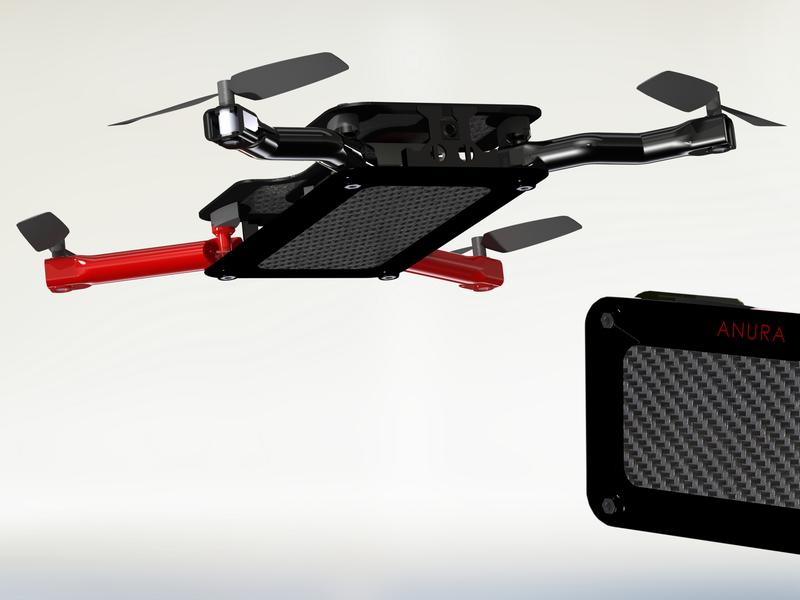Weekly Innovation: This Drone Fits In Your Pocket

The narrative around drones is that they are killing machines. Unmanned tools of war that the government uses to avoid putting boots on the ground in conflict zones around the world.
But drones are actually much more than that. In September, the Federal Aviation Administration gave approval to six Hollywood production companies to use drones for filming. Independent photographers and filmmakers like to use them, too, to get that perfect aerial shot.
And as NPR's David Schaper reported:
"Industries want permission to use drones for everything from surveying crops and pipelines, to real estate and wedding photography, even delivering packages. At least 40 applications seeking drone-use approval are pending before the FAA."
So what if there was a drone that fit in your pocket, that you could carry around 24/7?
That drone has arrived. The Anura from AeriCam is a quadcopter not much larger than an iPhone with propellers that fold in so you take it on the go.
The San Francisco-based drone company aims to put the product on Kickstarter this month, says Jason Lam, AeriCam's founder. Lam says the company hopes to attract 500 backers in order to keep the Anura below $200.
The drone connects with Apple and Android smartphones over Wi-Fi and has a built-in microcamera that shows aerial views on the phone's screen. The phone also serves as the drone's remote control.
"I think being small and being at a much more reasonable price, a lot more people will be able to own one than realize it," says Lam, who was a fashion photographer in New York City before founding AeriCam in 2009. "I think that also sparks a lot more interest in the drone industry, and you don't know what that will lead to."
Learning to fly the Anura is like playing a video game, Lam says. And even though the drone weighs less than 5 ounces, the Anura is durable.
"The big drones, one crash you usually have to repair it," Lam says. "These guys are quite stable, especially if you fly them inside at home."
Although it's noted for its small size, the Anura isn't the first personal drone out there.
The PlexiDrone, from Toronto-based robotics startup DreamQii, fits into a backpack when disassembled. The larger size comes with added features such as the ability to draw a flight path, obstacle detection and swappable parts. PlexiDrone doesn't have a camera built in but is designed to easily attach one, like a GoPro.
Another drone can actually be worn like a bracelet. With the flick of your wrist, the Nixie flies away and films you while you're climbing a mountain or riding the big wave. The creators plan to present the prototype at the Intel Make It Wearable Challenge Finale on Nov. 11 in San Francisco.
Lam says small, personal drones are changing the perception of how drones can be used — not just as machines of war.
Small drones like the Anura teach people "a little bit more about what the deal with drones is because it is a growing industry," he says. The drone industry will have an estimated economic impact of more than $82 billion by 2025, according to a 2013 report by the Association for Unmanned Vehicle Systems International.
But the implications of having commercial drones on the market are vast. The flying of small drones in the U.S. airspace is currently legal, an administrative law judge with the National Transportation Safety Board ruled in March.
The FAA appealed the decision, citing safety concerns. In 1981, the FAA issued voluntary guidelines for those flying model airplanes. The agency asked them not to fly above 400 feet and to stay away from airports.
Drones also raise privacy issues. Many worry about people using them for spying. Police in some states are prohibited from using drones for surveillance but can use them for search and rescue.
Lam recognizes these risks, but he also says the use of drones shouldn't be restricted too much just because some people will use them maliciously.
"People out there who want to do something like that, you can't really stop them," he says. "You always have a few people that's gonna try to do something."
Lam says people have been interested in flight for centuries, and he wanted to make that dream more accessible to the masses.
"I wanted these to be able to be enjoyed anytime," he says. "You don't have to plan to go out and fly. It's not an event that you have to create. This is like, 'Oh, I just want to fly now.' You have access to a real aircraft."
In our "Weekly Innovation" blog series, we explore an interesting idea, design or product that you may not have heard of yet. Do you have an innovation to share? Use this quick form.
9(MDEwODYxNTQyMDEzNjAxODk2Nzc2NzNmYQ001))